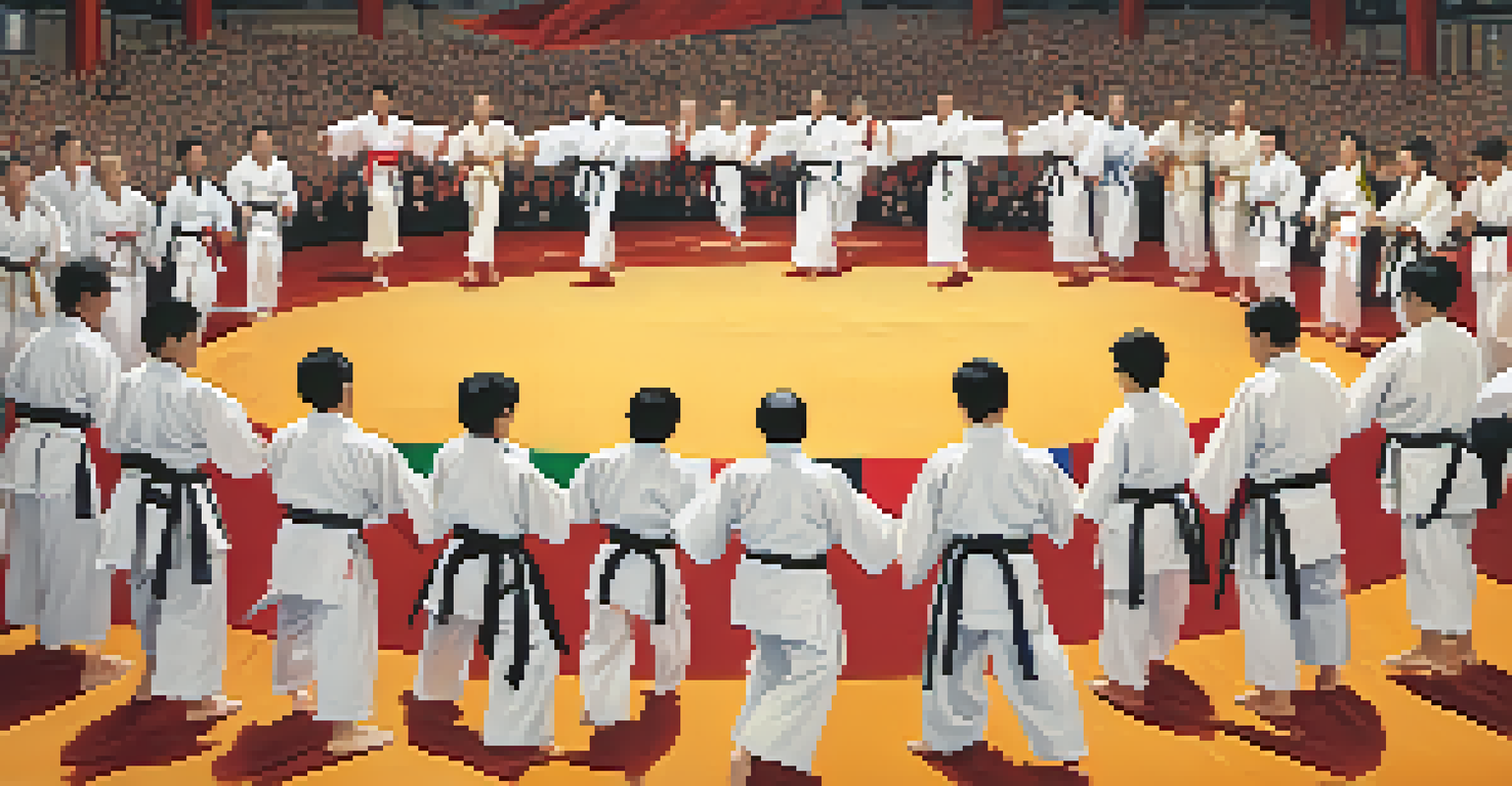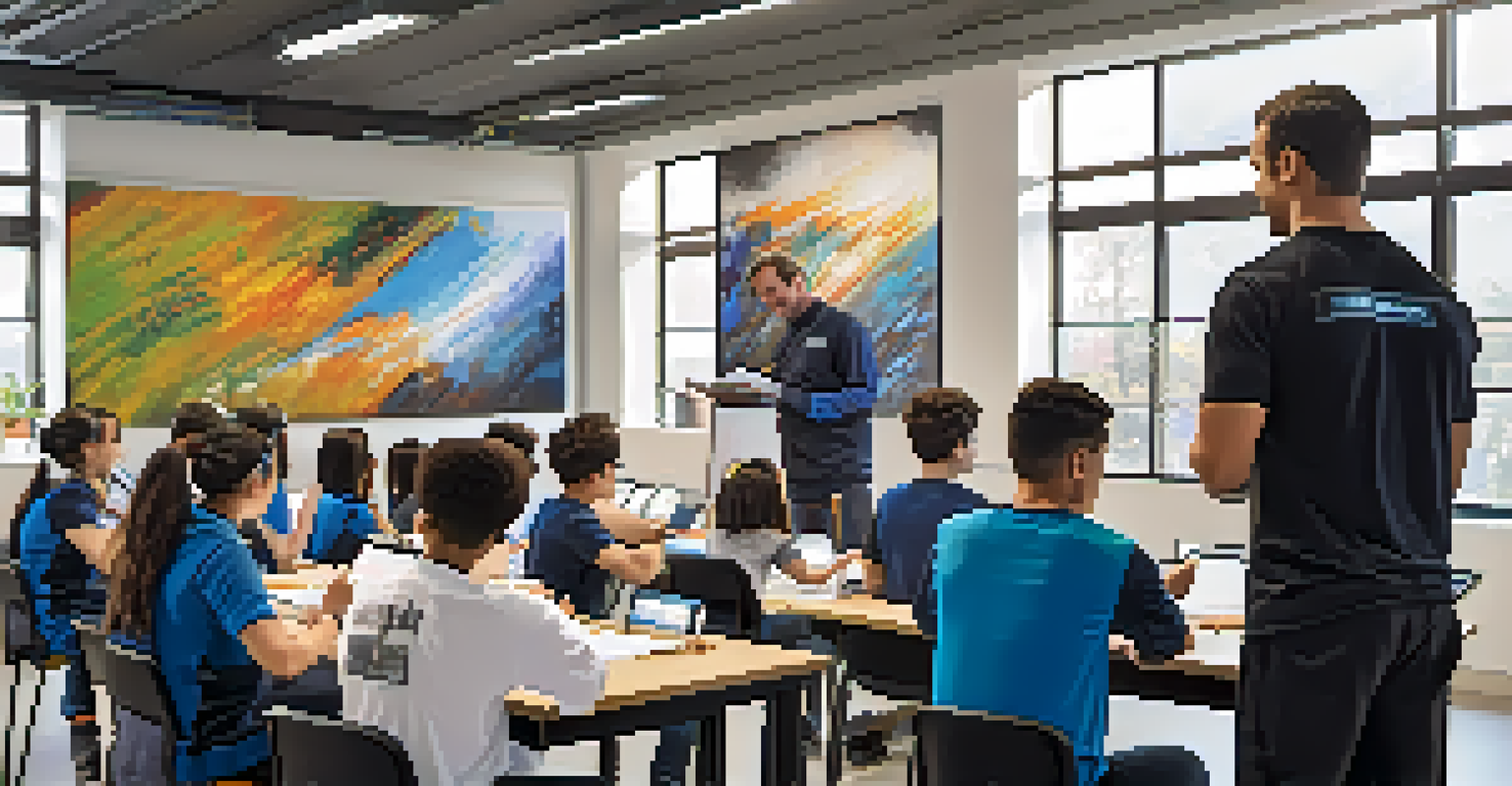Martial Arts and Globalization: A Mixed Blessing?

Understanding Martial Arts in a Global Context
Martial arts have deep cultural roots, often tied to the history and philosophy of their countries of origin. As various styles like Karate, Taekwondo, and Brazilian Jiu-Jitsu spread globally, they bring with them unique practices and values. This globalization allows for a richer exchange of techniques and ideas, creating a more diverse martial arts landscape.
Martial arts is not about the physical strength; it’s about the strength of the mind and the spirit.
However, the rapid spread of martial arts can sometimes dilute their original meanings and intentions. For instance, traditional practices may be simplified or commercialized to appeal to a broader audience. This raises questions about authenticity and the preservation of cultural heritage in the face of globalization.
Ultimately, understanding martial arts in a global context highlights both the opportunities and challenges posed by this phenomenon. It is crucial to appreciate the cultural significance behind each style while embracing the benefits of shared knowledge and techniques across borders.
Cultural Exchange: A Double-Edged Sword
Cultural exchange is one of the most significant benefits of globalization in martial arts. Practitioners from different backgrounds can learn from one another, enhancing their skills and broadening their perspectives. For example, cross-training in various styles can lead to innovative hybrid techniques that enrich the martial arts community.

However, this exchange can also lead to cultural appropriation, where aspects of a culture are adopted without proper understanding or respect. This often occurs when martial arts are commodified, reducing profound traditions to mere trends or fitness fads. Such practices can undermine the very essence of these art forms, leading to dissatisfaction among traditionalists.
Cultural Exchange in Martial Arts
Globalization allows martial artists to learn from diverse styles, enriching their skills while raising concerns about cultural appropriation.
Finding a balance between embracing new influences while respecting the roots of martial arts is essential. It encourages a mutual appreciation for different cultures, fostering a global community that honors the origins of each martial art.
Commercialization and Its Impact on Martial Arts
Globalization has led to the commercialization of martial arts, transforming them into lucrative businesses. Fitness studios and franchises often prioritize profit, promoting martial arts as trendy workout options. While this can make martial arts more accessible to a wider audience, it sometimes sacrifices the depth and discipline that originally defined these practices.
The essence of martial arts is not about the fight, but about the philosophy behind it.
For instance, a martial arts class advertised as a 'fun workout' may prioritize physical fitness over the traditional philosophies of respect and honor. This shift can create a generation of practitioners who lack a deeper understanding of martial arts' cultural significance. Consequently, the true essence of martial arts may be overshadowed by a focus on marketability.
Despite the challenges posed by commercialization, it can also provide opportunities for growth and awareness. By leveraging modern marketing strategies, traditional martial arts can reach new audiences, potentially sparking interest in their historical roots and philosophies.
The Role of Technology in Martial Arts Education
Technology has revolutionized how martial arts are taught and practiced globally. Online classes, instructional videos, and social media have made it easier for enthusiasts to learn from top instructors worldwide. This accessibility can help practitioners refine their skills and stay connected to a broader community, regardless of geographical limitations.
However, not all technology-driven learning is beneficial. The absence of in-person training can lead to a lack of personalized feedback, which is crucial for mastering techniques. Additionally, the overreliance on online resources may contribute to a superficial understanding of martial arts, where practitioners miss out on the rich cultural narratives behind the techniques.
Impact of Commercialization
The commercialization of martial arts makes them more accessible but can dilute their traditional values and philosophies.
Ultimately, while technology can enhance martial arts education, it is vital to strike a balance between virtual learning and traditional training methods. Incorporating both can lead to a more comprehensive understanding and appreciation of martial arts.
Global Competitions: Uniting or Dividing Martial Arts?
International competitions have emerged as a significant aspect of global martial arts culture. Events like the World Taekwondo Championships or the IBJJF World Jiu-Jitsu Championship bring together practitioners from diverse backgrounds, fostering a spirit of camaraderie and mutual respect. These events can help elevate martial arts as a global sport, promoting healthy competition and cultural exchange.
However, the competitive nature of these events can sometimes overshadow the philosophical teachings inherent in martial arts. The drive to win may lead to a focus on performance over principles, where winning becomes the primary goal rather than personal growth and discipline. This shift can alienate some traditionalists who view martial arts as a lifelong journey rather than a mere sport.
Navigating this tension is crucial for the future of martial arts. Striking a balance between competition and tradition can ensure that martial arts continue to be celebrated for their cultural significance while thriving in the global sports arena.
Preserving Tradition in a Globalized World
As globalization continues to shape the landscape of martial arts, preserving traditional practices becomes increasingly important. Many organizations and schools are working to maintain the integrity of their martial arts styles through dedicated training programs, seminars, and cultural exchanges. These efforts help ensure that the core values and techniques are taught to future generations.
Moreover, some practitioners advocate for a return to the roots of martial arts, emphasizing the importance of understanding the history and philosophy behind techniques. This approach can foster a deeper connection to the art form, enriching the training experience for individuals who seek more than just physical fitness.
Balancing Tradition and Modernity
Preserving the core philosophies of martial arts is essential as practitioners navigate the challenges and opportunities presented by globalization.
Ultimately, preserving tradition in a globalized world requires a conscious effort from both instructors and students. By honoring the past while engaging with the present, martial arts can continue to thrive in a way that respects their cultural heritage.
The Future of Martial Arts in a Globalized Society
Looking ahead, the future of martial arts in a globalized society presents both challenges and opportunities. As more people become interested in martial arts for fitness or self-defense, there is potential for greater cultural exchange and understanding. However, the risk of losing traditional values remains a constant concern.
To navigate this future, practitioners and instructors must remain committed to the core philosophies of martial arts. Emphasizing respect, discipline, and personal growth can help maintain the integrity of these practices, even as they evolve in response to global trends. Incorporating educational programs that teach the history and significance of various styles can also foster a greater appreciation for their roots.

In conclusion, the future of martial arts in our interconnected world depends on our ability to balance globalization with tradition. By embracing change while honoring the past, martial arts can continue to thrive and inspire individuals across the globe.